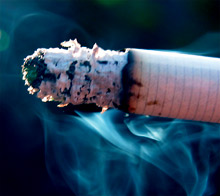
Those who are of opinion that they are not at the risk of cancer, since they don't smoke, should be get alert as even being a passive smoker or getting exposed to secondhand smoke can make them susceptible to cancer. A key protein linked to cell function and regulation get stopped by cancer-causing agent present in gaseous phase of cigarette smoke, a new research led by Indian origin scientist has revealed.
Here it is worth noting that cigarette smoke for long is identified as a cause of lung cancer and is linked with various other forms of cancer in adults.
Cigarette smoke contains more than 4,000 components, majority of them are associated with the development and progression of lung cancer.
There are proofs that secondhand smoke is as dangerous as primary smoke due to its effects on the cells of the body.
A team of researchers led by A. K. Rajasekaran, PhD, Director of the Nemours Center for Childhood Cancer Research, reached at a conclusion that a cancer-causing substance called reactive oxygen species (ROS) present in the gaseous phase of cigarette smoke. This substance has the ability to prevent normal cell functions.
The team of researchers has made startling revelations. The study has found that exposure to the secondhand smoke of even two cigarettes was found to almost fully inhibit the function of a cell's sodium pump within a few hours.
The sodium pump plays a very important role in normal cells, as it transports potassium into the cell and sodium out of the cell. The capability of the cell's sodium pump, i.e., its inability to regulate sodium, is a sign of cell damage, disease progression and ultimately, survival.
"This is critical information with regard to secondhand smoke," Dr. Rajasekaran lead of the study said.
"We now know that one need not inhale the particulate matter present in secondhand smoke to suffer the consequence of smoking. Exposure to the gaseous substance alone, which you breathe while standing near a smoker, is sufficient to cause harm." Dr. Lee Goodglick, Associate Professor in the Department of Pathology and Laboratory Medicine, UCLA, and co-senior author of the study has been quoted as saying.
"Few reliable lung cancer biomarkers that could predict survival, treatment options or response to therapy exist today. Even fewer have been recognized where the function of the biomarker is known, yielding important information about the mechanism of action. This study really accomplishes both," Dr Goodglick has been quoted as saying.
Online edition of the American Journal of Physiology - Lung Cell and Molecular Physiology has published this study.
--With inputs from ANI
|
|
Read More: American Samoa | National Physical Laboratory | Indian Press | Matri Indian Antartic Station | 3 Eme Center | Spinning Mills Center | Agricultural Research Centre | Central Leather Research Insti | Indian Institute Of Technology | Indian Research Po | Haringhat River Research Insti | Rubber Research Station | Anelih | Anini | Kamlang Nagar | Kherem | Indian Nation | Indian School Of Mines | Childhood Obesity | Cancer


Comments: